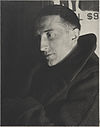Rrose Sélavy

Rrose Sélavy, or Rose Sélavy, was one of the pseudonyms of artist Marcel Duchamp. The name, a pun, sounds like the French phrase "Eros, c'est la vie", which translates to English as "Eros, that's life". It has also been read as "arroser la vie" ("to make a toast to life").
Sélavy emerged in 1921 in a series of photographs by Man Ray of Duchamp dressed as a woman. Through the 1920s, Man Ray and Duchamp collaborated on more photos of Sélavy. Duchamp later used the name as the byline on written material and signed several creations with it.
Duchamp used the name in the title of at least one sculpture, Why Not Sneeze, Rose Sélavy? (1921). The sculpture, a type of readymade called an assemblage, consists of an oral thermometer, a couple dozen small cubes of marble resembling sugar cubes and a cuttlefish bone inside a birdcage. Sélavy also appears on the label of Belle Haleine, Eau de Voilette (1921), a readymade that is a perfume bottle in the original box. Duchamp also signed his film Anemic Cinema (1926) with the Sélavy name.
From 1922 the name Rrose Sélavy also started appearing in a series of aphorisms, puns, and spoonerisms by the French surrealist poet Robert Desnos. Desnos tried to portray Rrose Sélavy as a long-lost aristocrat and rightful queen of France. Aphorism 13 paid homage to Marcel Duchamp: "Rrose Sélavy connaît bien le marchand du sel" ‒ in English: "Rrose Sélavy knows the merchant of salt well"; in French the final words sound like Mar-champ Du-cel. Note that the 'salt seller' aphorism – "mar-chand-du-sel" – is a phonetic rearrangement of the syllables in the artist's actual name: "mar-cel-du-champ." (Duchamp's compiled notes are titled 'Salt Seller'.) In 1939 a collection of these aphorisms was published under the name of Rrose Sélavy, entitled Poils et coups de pieds en tous genres.
The inspiration of the name Rrose Sélavy has been viewed to be Belle da Costa Greene, J.P. Morgan's librarian of The Morgan Library & Museum (formerly The Pierpont Morgan Library) who, following his death, became the Library's director, working there for a total of forty-three years. Empowered by J.P. Morgan, and then by his son Jack, Greene built the collection buying and selling rare manuscripts, books and art.[1]
The late Ilmar Laaban – an Estonian poet, lecturer, polyglot and intellectual who died in exile in Sweden, often called "the father of Estonian surrealism" ‒ wrote a collection of poetry called "Rroosi Selaviste" in Estonian that is based on wordplay and puns. Published in 1957, it is without a doubt one of his major accomplishments, a playful homage to his native tongue that not only shows the suppleness of the Estonian language, but also Laaban's virtuosity as a wordsmith.
Niandra LaDes, an alter ego of John Frusciante, was based on Rrose Sélavy. This character is also featured on the cover of Frusciante's 1994 album Niandra LaDes and Usually Just a T-Shirt, which is a screenshot from a film by Frusciante's then-girlfriend, Toni Oswald. This film remains unreleased, though a tradition among the avant-garde is to show the film in the proximity of items bearing a similar resemblance to a Duchampian "fountain".[2]
Popular Culture
- Oyster bar Sel Rrose in Manhattan's Bowery neighborhood is named after Rrose Sélavy.[3]
Notes
References
- Rrose Sélavy, Man Ray (1921) by Jonathan Jones in The Guardian.
- Mention of Sélavy at DaDa Online.
- Duchamp Bottles Belle Greene: Just Desserts For His Canning by Bonnie Jean Garner (with text boxes by Stephen Jay Gould)

